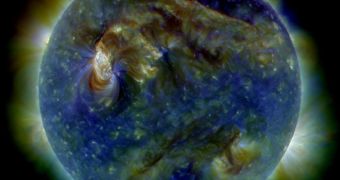According to a new research study by astrophysicists, it would appear that when the Sun experiences its most violent explosions, it does so at a massive scale, which sees the entire star trembling under the intensity of the blast.
The explosions are all inter-connected through enormous magnetic threads, some of which have been measured to have hundreds of thousands of miles in length.
This type of event can be caused by either solar flares, coronal mass ejections or other variety of solar storm, the researchers believe. Furthermore, several of each type of events may take place on our star at the same time, the team said yesterday, December 13.
In the past, solar physicists who have been keeping an eye on the Sun's activity have only looked at how the star behaves in isolated parts, but the new data suggests a more thorough look is advisable.
One of the main implications of this paradigm shift is that the forecast of space weather – the sum of all effects the Sun produces in the solar system – will become increasingly difficult at first.
But experts bring good news, saying that the advantage would be that the accuracy of the forecasts would also increase considerably, if all phenomena taking place on the Sun are taken into account.
“To predict eruptions, we can no longer focus on the magnetic fields of isolated active regions. We have to know the surface magnetic field of practically the entire Sun,” explains scientist Alan Title.
The Stanford University expert is the co-author of a new study detailing the findings, as well as a researcher at the Lockheed Martin Advanced Technology Center, in Palo Alto, California.
An August 1 solar event was used as a reference point for the study. The phenomenon saw nearly half of the Sun erupting, in an event that sent shock waves across the entire solar surface.
Additionally, massive hot gas clouds were emitted into space, and all of this because of an event that would have otherwise been classified as localized, experts said at the annual fall meeting of the American Geophysical Union, which was held in San Francisco.
Both the Solar Dynamics Observatory (SDO) and the Solar Terrestrial Relations Observatory (STEREO) space telescopes observed the event in minute detail. They essentially found the first solar tsunami ever discovered.
But “we're not seeing everything” from Earth. “We have to expand our view and look well beyond the region exploding,” says LM Solar and Astrophysics Lab expert Karel Schrijver, also a coauthor of the investigation, Space reports.

 14 DAY TRIAL //
14 DAY TRIAL //